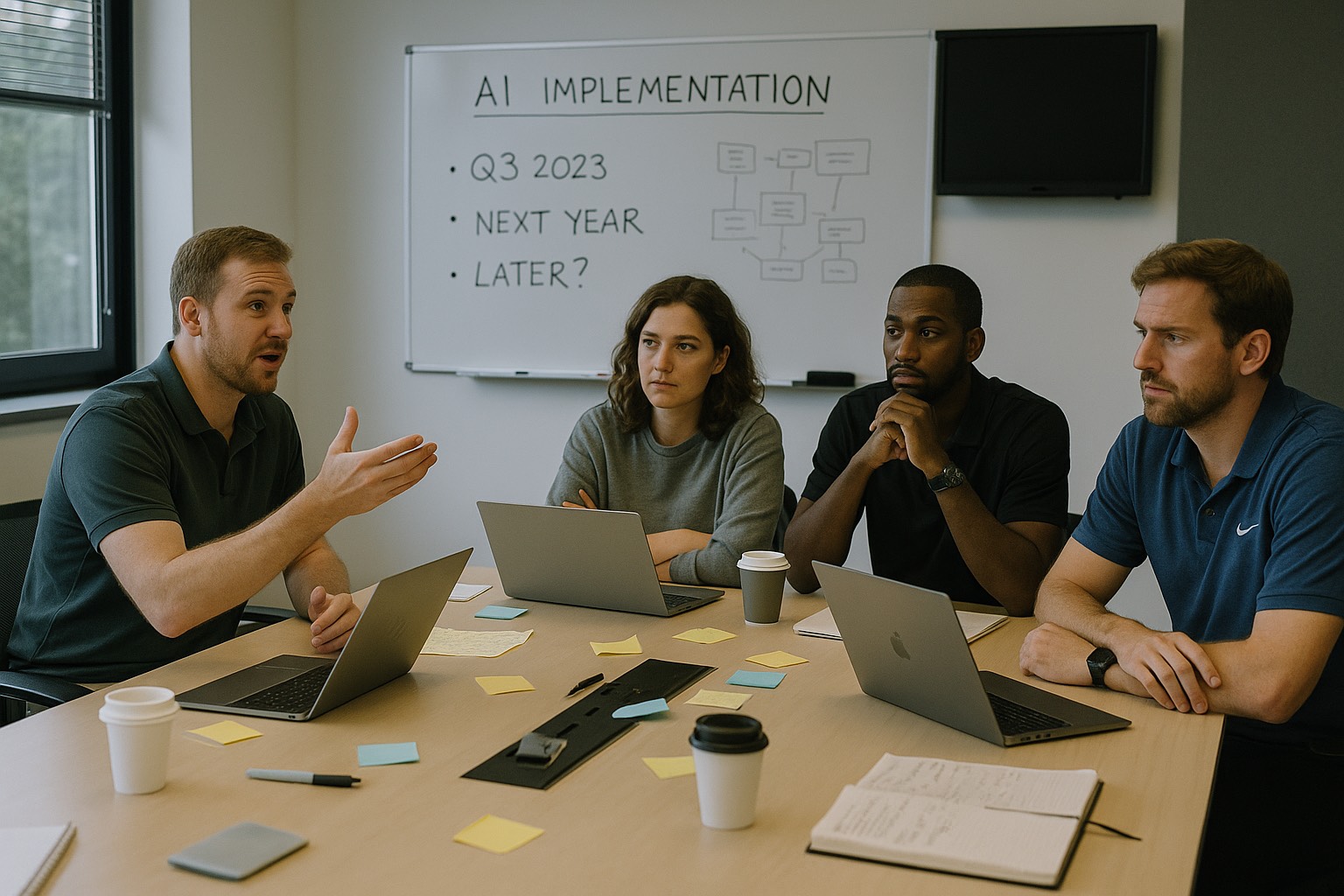

The fear no one talks about: but every sport’s leader feels.
3 Min Read
The fear no one talks about: but every sport’s leader feels.
There are 3 kinds of sports leaders I see right now:
I’ve worked with sports brands for over a decade, but in the past 18 months, as I’ve helped them navigate AI, I keep seeing the same three postures.
Before I share them and invite you to consider which one is closest to you, there’s a story that explains what I mean:

Out of gas.
Middle of nowhere. No phone signal. Just one house in the distance… He grabs an empty bottle and starts walking. On the way, his mind starts spiraling: “What if the guy yells at me?” “What if he slams the door?” “What if he thinks I’m trying to scam him?” “Screw him.”
By the time he reaches the door, he’s already furious.
He knocks. A guy opens the door. And without missing a beat, he shouts:
“You know what? Screw you and your gas!”
Fear doesn’t kill us the stories we invent do.
And when it comes to AI, we all have a story running.
This week, GPT-5 was released…And this fear? It’s not irrational.
We’re living through a WAVE that’s already reshaping everything we do.
And unlike previous waves: digital, mobile, social, this one moves faster, cuts deeper, and touches more of who we are.
It’s not just about jobs or productivity.
It’s about relevance, Confidence and a new level of uncertainty.
Now let’s look at the 3 kinds of sports leaders I see right now.
1. The Balcony Observers:
They hear the noise but don’t feel the urgency. They believe the industry will evolve gradually. To them, AI still feels like a buzzword not yet a necessity.
2. The Soon-ish Club:
They know change is coming. They want to act but competing priorities, internal politics, or uncertainty hold them back. They’re not resisting. They’re just not moving.
3. The Brave Few:
They’re experimenting. They’re making small, smart bets.They’re not just learning about AI they’re learning about their leadership, their culture, and how they want to move forward. Most people aren’t in group three.
But many want to be. They’re just not sure how.
And that’s where this gets interesting.

You are not alone:
In conversations with CEOs, CMOs, and innovation leads, I rarely hear anyone say they’re afraid of AI. Instead, I hear thoughtful, strategic responses:
- “Let’s not rush. We’ll wait and see what others do.”
- “We’re exploring AI, but it’s not the right time yet.”
- “We want to be thoughtful, not just jump on the trend.”
- “We’ll do it when we have a proper budget and clear ROI.”
All of these make sense.But in quieter, more honest moments, something deeper often comes through:
- “I’m not sure I fully understand this.”
- “I don’t want to make the wrong move.”
- “What if I get left behind?”
These aren’t technical concerns. They’re emotional. They’re about relevance, confidence, and identity. And that’s where the real opportunity lies.
1. Start by Naming What’s Here Gently
You don’t have to call it fear. You don’t have to dramatize it.
But it’s worth noticing: Something might be making you hesitate.
It might be the speed of change. The expectation to “sound informed.” The unfamiliarity of the space. That’s okay. It’s human. And it’s more common than you think.
Sometimes, just quietly naming what’s there creates space to move.
2. Look Beneath the Surface
Often, what AI challenges isn’t our intelligence, it’s our identity.
Questions like:
- “Do I still belong at the forefront of this industry?”
- “Is my experience still relevant?”
One executive at a European football club told me: “For the first time in my career, I’m not sure how to lead a conversation. And that’s uncomfortable.”
That discomfort isn’t a weakness. It’s a signal. And if you lean into it with curiosity not shame it can be a source of strength.
3. Redefine What Leadership Looks Like Now
In this new era, leadership doesn’t require technical depth.
It requires emotional depth. Not knowing everything. But asking better questions.
Creating space for younger voices. Modeling openness in the face of uncertainty.
What your team needs isn’t a tech genius. It’s a grounded, human leader.
4. Move Gently But Move
Here’s what starting might look like:
- A simple conversation No slides. No pitch. Just ask: “What’s exciting or confusing about AI for you right now?”
- A small test A Serie A club used AI to optimize merchandise pricing during matchdays. Result? A 12% increase in same-day sales. Simple. Low risk. Immediate insight.
- An on-field pilot An Olympic federation applied AI-powered video tagging in training. It reduced review time by 40% and improved athlete feedback loops.
Result? Higher precision, less friction. - A weekly rhythm Block one hour a week to read, reflect, or test a tool.
Not a project a habit.
Start small.
Stay human.
Keep going.
5. Your Real Advantage Has Nothing to Do With AI
The reason people follow you isn’t because you mastered AI. It’s because you stayed present when others checked out. Because you listened when others pretended.
Because you kept asking questions even when it was easier to stay quiet.
AI will keep evolving. So will the tools. So will the noise.
But this won’t change: People follow people. Especially those who lead with clarity, humility, and groundedness when it matters most.

Final Thought
You don’t need to be first. You don’t need to be the most technical. You don’t even need to be confident yet. But you do have an opportunity:
To meet this moment honestly.
To lead from presence, not performance.
To stay open, even when it feels uncomfortable.
AI isn’t a technical transformation. It’s a personal one.
It was Joseph Campbell that said: “In the cave you fear to enter lies the treasure you seek.”
With Love for Sports and Innovation,
AR




Comments
Beverly Ryan-Redfern
Extremely well written and I can totally relate to this message. I'm currently uncomfortable with being pushed to adopt AI,but on reflection realise that I'm using it everyday anyway. Just had to remember the 5 stages to learning ,apply to what ever new skills are required .Thank you for the inspiration to carry on and remain authentic.